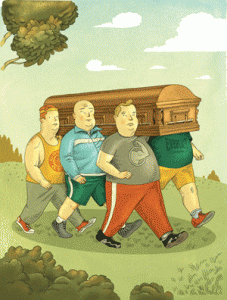Just as Congress was concluding a contentious year of debate by passing legislation to overhaul the health care system, a revealing look at lifestyle, income and mortality was published in the journal Social Science & Medicine. It followed a cross-section of American adults to determine precisely which factors drive us to an early death.
Some of the answers were expected. Cigarette smoking. A sedentary lifestyle. Being poor.
One well-publicized issue did not make the list: Obesity. For all the breathless media coverage of our collective weight gain over the past few decades, it turns out that unless one is morbidly obese, those extra pounds are not a significant risk factor for premature death.
This does not mean the lead author of the aforementioned study, Paula Lantz, is proposing we all relax and pig out. The University of Michigan social epidemiologist fully recognizes obesity as a national health problem. But her research suggests our current focus on weight is a bit (ahem) narrow and at least somewhat misleading.
In the popular imagination, lack of exercise and obesity tend to be lumped together as a health problem, as do low income and low education levels. But Lantz has managed to isolate these factors, and in doing so she has brought welcome clarity to a confusing discussion.
Yes, she argues, a sedentary lifestyle contributes to obesity, but it is also a risk factor for mortality in and of itself. Sitting and staring at the television for hour upon hour is hazardous for your health whether or not you are munching Cheetos as you change channels.
In This Issue
Lobbying doesn’t usually work; fat won’t kill you; and the Dead Sea doesn’t need to die. Check out those stories, our cover story on oxytocin shaking up the field of economics and much more in the September-October 2010 issue of Miller-McCune magazine.

A research professor, Lantz is chairwoman of the university’s department of health management and policy, and director of the Robert Wood Johnson Foundation’s Scholars in Health Policy Research Program in Ann Arbor, Mich. With degrees in sociology, epidemiology and social demography, she is a nationally recognized authority on the health status of Americans. She recently spoke with Miller-McCune about her latest findings.
Miller-McCune: Let’s start by describing the data set you used for this new analysis, the Americans’ Changing Lives study. It features information on about 3,600 adults — that is, people who were 25 or older when the first wave of data was collected in 1986. What makes this a good sample to study?
Paula Lantz: It was set up to follow a population of adults over time to find out what contributes to healthy aging. It’s ongoing — we’re looking at people at more than one point in

time — and it’s national in scope. Other studies have a larger sample size, but they’re not nationally representative. We’ve been following this population for 19 years, looking at who died, who didn’t, and how this relates to patterns of people’s social characteristics or behaviors. At the time we did our analysis for this paper, 30 percent of the people in the sample had died. We get [cause of death] information from death certificates.
M-M: Your focus in this study was “risk factors for mortality.” What exactly does that mean?
PL: Characteristics or behaviors that might be associated with an increased risk of dying earlier than you would expect otherwise. Smoking is a risk factor for mortality, as smokers will die at a younger age if everything else is equal.
M-M: You concluded that, compared to people in a normal weight range, neither being overweight nor obese is significantly associated with mortality risk. In fact, those conditions were actually protective against mortality for people over age 55. Did those people surprise you?
PL: No. If you take a representative sample of the general population and follow them forward, there are not very many studies that find an increased risk of mortality due to obesity. The only exception is the morbidly obese — those with a body mass index of 35 and above. They represented 3 percent of our study, although it’s a growing number in the U.S.
M-M: So is our concern about obesity overblown?
PL: I do think concerns about the relationship between obesity and mortality have been a bit overblown. Unless you’re controlling for a lot of other things associated with obesity, you’re going to overestimate the impact of obesity. What our results suggest is a lack of physical activity is a much stronger predictor of mortality than is obesity.
M-M: Why is that?
PL: There are a lot of mechanisms by which physical activity can reduce the negative effects of certain chronic conditions, especially related to heart disease and stroke. Being physically active has great benefits for your cardiovascular system. It can also reduce stress.
M-M: So why are both the government and the media so focused on weight?
PL: For some good reasons. Obesity is leading to a very different public health problem: A lot of people are living for a long time with serious chronic illnesses that are caused by, or exacerbated by, obesity. We’re talking diabetes, arthritis, heart disease, some kinds of cancer. These diseases reduce people’s quality of life, and treating them is expensive.
M-M: Traditionally, people have put on weight later in life, but in recent decades childhood obesity has become a growing problem. Are we in uncharted territory as we look ahead and ask what the health effects will be of being heavy one’s entire life?
PL: We are. We have all these kids now who have been overweight their entire lives. That could definitely be a risk factor for premature mortality, but we can’t speak to that now.
M-M: You identify smoking as a major risk factor for premature death. So it’s good news that the percentage of Americans who smoke cigarettes continues its steady decline. If smoking can become less socially acceptable, does that suggest some of the other bad health behaviors we currently engage in can also decline over time?
PL: Yes. We can take a lot of lessons from what we learned about tobacco use, prevention and control and apply them to the promotion of more healthy lifestyles. A lot of factors contributed to making the smoking rates go down. It is not a case where people got more information, understood it was bad for them and quit doing it.
Taxing cigarettes was, and is, a huge factor. Kids are more price-sensitive than adults, and in the U.S., people start smoking when they’re adolescents. Preventing kids from starting to smoke [by making cigarettes prohibitively expensive] is a big part of the story.

Applying that concept to obesity, taxing sugared beverages — which has happened in a few places — could make a huge difference. It could also generate revenue for states that are struggling fiscally right now. But politically, it’s a hard sell.
I’ve come to believe soda is really a problem. The rise of obesity among kids is highly correlated with the increase in consumption of soda and other sugared beverages. The studies suggesting that are pretty compelling. If you just drink two Cokes a day, that’s a lot of extra sugar.
M-M: Presumably if you get people moving more, the obesity problem will abate somewhat, since at least people will be burning more calories. Are there studies showing what we think of as intuitively true — that people are more sedentary in this day of staring at computer screens all day?
PL: I think that’s very well established, and it concerns me very much. We need policy and program interventions to emphasize the importance of physical activity. I wouldn’t take the focus away from obesity; both are important, and we’re going to have to attack both of them.
M-M: What other trends are contributing to the problem?
PL: One factor is the changes in our built environment. We’re much more dependent on cars than we were even 30 years ago. Sprawling suburbs aren’t really conducive to walking from place to place, and in inner cities you’ve got broken sidewalks, parks that haven’t been kept up in some places and concerns about safety. To intervene in the obesity problem and the physical activity problem, there is going to have to be attention paid to the built environment.
Obviously, there is an element of personal responsibility in all this. But looking at this sociologically, it plays out differently in different social strata. There is a fundamental lack of basic resources in some neighborhoods. It’s hard to take personal responsibility if you don’t have the money to join a gym and you have no access to healthy food in your immediate neighborhood. The place where you can get the most calories for the least money is McDonald’s. Their food is dirt cheap on a per-calorie basis.
M-M: This brings up another interesting finding of your study, which is the strong link between mortality and socioeconomic level.
PL: It looks like education level is the main thing predicting whether people get a life-threatening illness in the first place. This is related to health behaviors. Smoking rates are a perfect example: They’ve gone down among all groups, but they’re way down among people with a college education.
But the onset of illness and the progression of illness are two different stories. Once you’re sick, income becomes much more important. The issue becomes how you manage it, which determines whether people die from the illness and if so, how soon. Access to medical care is part of the story, but it’s not the entire story. Even if everyone in the country had the exact same health insurance and the exact same access to care, we would still see these disparities — as we do in countries that have national health insurance.
M-M: So why is being poor hazardous to your health?
PL: Stress processes probably play a role. Chronic stress is not good for immune function. [Difficulties with] housing, transportation, income security — all those factors can produce stress. Do you have friends and family — people who can actually help you get to the doctor? Is your community organized in such a way that it provides the resources you need?
M-M: Do you think the health care reform bill that recently passed will have an impact in terms of lessening the disparities in health in this country?
PL: The bill that passed is a big beast. The main thing it does is extend health insurance coverage to a greater number of Americans. That’s a good thing, a necessary thing, but it’s not sufficient to reduce disparities. There is funding in the bill for more community-based prevention. That’s a good start. There is recognition within the bill that health and health care are not the same thing.
M-M: What factors are you looking at as this new system begins to take shape?
PL: I’m worried that the focus will be on the health insurance exchanges and expanding Medicaid, while the broader mission of public health will be subsumed. In public health, we talk about primary prevention — let’s stop diseases before they occur. That’s where a lot of effort needs to be made, but states will be very focused on the health insurance part of this. I want to make sure the broad mission of public health will still be in the forefront.
M-M: How do physicians react when you present them with your findings?
PL: They’re not that surprised. A lot of physicians have said to me, “One of the messages from your paper we want to start touting is the physical activity finding — that any level of physical activity helps reduce mortality. Now I can tell my patients: Don’t worry so much about the weight right now. Just get off the couch!”




